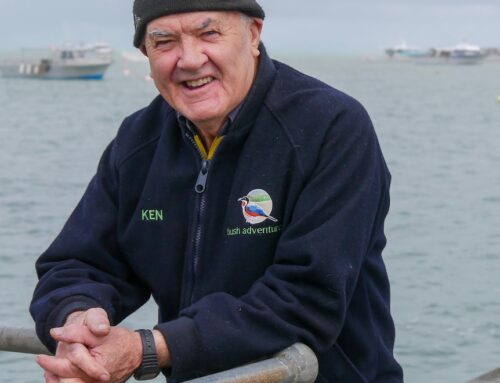In June 2021, Natasha Biggins was trying to sell a wardrobe.
After living in cities around the world she was based in a one-bedroom unit in Adelaide.
A fourth-generation sheep farmer from Naracoorte on South Australia’s Limestone Coast, the pandemic had her seriously questioning where she wanted to bide her time.
An offer from her brother to house-sit his farm for a few weeks directed her next steps.
“I went from living in my one-bedroom unit with no pets to looking after … five thousand sheep, three cats, four dogs … chopping all my own firewood,” Natasha said.
A chance encounter with Narracoorte Homestead weeks later stirred her to buy the three-acre site, Naracoorte’s first dwelling, with little thought.
After 10 years on the market, the historic property was back in local hands.
“I have been inundated by support from the community,” Natasha said.
Managing the three dwellings and surrounding gardens is no light task.
While experienced in business and tourism, Natasha has had to quickly learn about English cottage gardens, stone masonry and irrigation systems for the property’s reopening as a bed and breakfast this Easter.
“I feel like I’m a bit of an Alice in Wonderland. I’m a bit overwhelmed by it all,” she said.
Buying a 180-year-old property
Unaware of the homestead until her mid-20s, Natasha did not know it was on the market until a walk with her mum in August 2021.
“We actually went to about three or four different locations to try and get away from the wind and we ended up walking past here and the sale sign out the front that had sat there for 10 years,” Natasha said.
It was. Although it was a while before she could get in and have a look.
“Unfortunately, South Australia had gone into a mini lockdown that week,” Natasha said.
Previously restored and run as a bed and breakfast, the place was in pretty good nick.
The main homestead was the last building added to the site and consists of four bedrooms and living and dining rooms. A kitchen has been added in more recent years.
“The cooking facilities were previously in another building so they didn’t burn the house down,” Natasha said.
The first thing to be built on the site was a lime-washed stone cottage — Naracoorte’s first dwelling — in 1842.
“William Macintosh bought it from him and obviously he’s got his stamp all over Naracoorte.”
After adding a three-floor building to the site he eventually sold it to Thomas and Elizabeth Magarey who built the main homestead.
“It’s such a small space and the three most significant families in this town’s history have each put their stamp on one building,” Natasha said.
While the homestead is considered a lavish residence now, Natasha believes Naracoorte’s “forefathers” did not have anything like the finery in there today.
Learning the history
Natasha has recruited the help of Judy Murdoch, an 88-year-old historian — and her former high school teacher — to collate the property’s history.
“She’s very happily handing over all of her information to me,” Natasha said.
Prior to Natasha’s ownership, history of the property has remained scattered.
“For some reason it just hasn’t been something that people had the time to focus on here,” she said.
Locals have gotten in touch with extra anecdotes and personal connections to the place.
She is relying on one neighbour to help her link in with the local Meintangk community to document the site’s earliest inhabitants.
“[There are] scarred trees here that have been identified as 450 and 500 years old … you can see a shield and a canoe have been cut out of them,” Natasha said.
“I think it’s really important for us to understand that there was a lot more that happened there.
The spelling of Narracoorte Homestead is intentional and nods to the Indigenous word meaning large waterhole, or place of running water.
“I think it’s possibly because the creek was here and there may have been a lot of low-lying water before we did this drainage work in the area to make it more accessible for farming,” Natasha said.
Returning to Naracoorte
Natasha feels deeply connected to the land she has begun to call home again.
“I love this environment because it’s what I know from my childhood,” she said.
Like Natasha, there’s a sense that the homestead has also returned to the township.
“The whole neighbourhood has really made this their backyard,” Natasha said.
“I think it’s really lovely because look at this space, you wouldn’t want it there taunting you from across the fence.”
As well as maintaining the homestead, she is determined to share the place and its history, and has big visions of period drama plays and events.
She has time to pull it all off.
“I’ll be here till I’m a very old lady,” she said.
“I’m not going anywhere. And why would you want to?
Posted , updated




